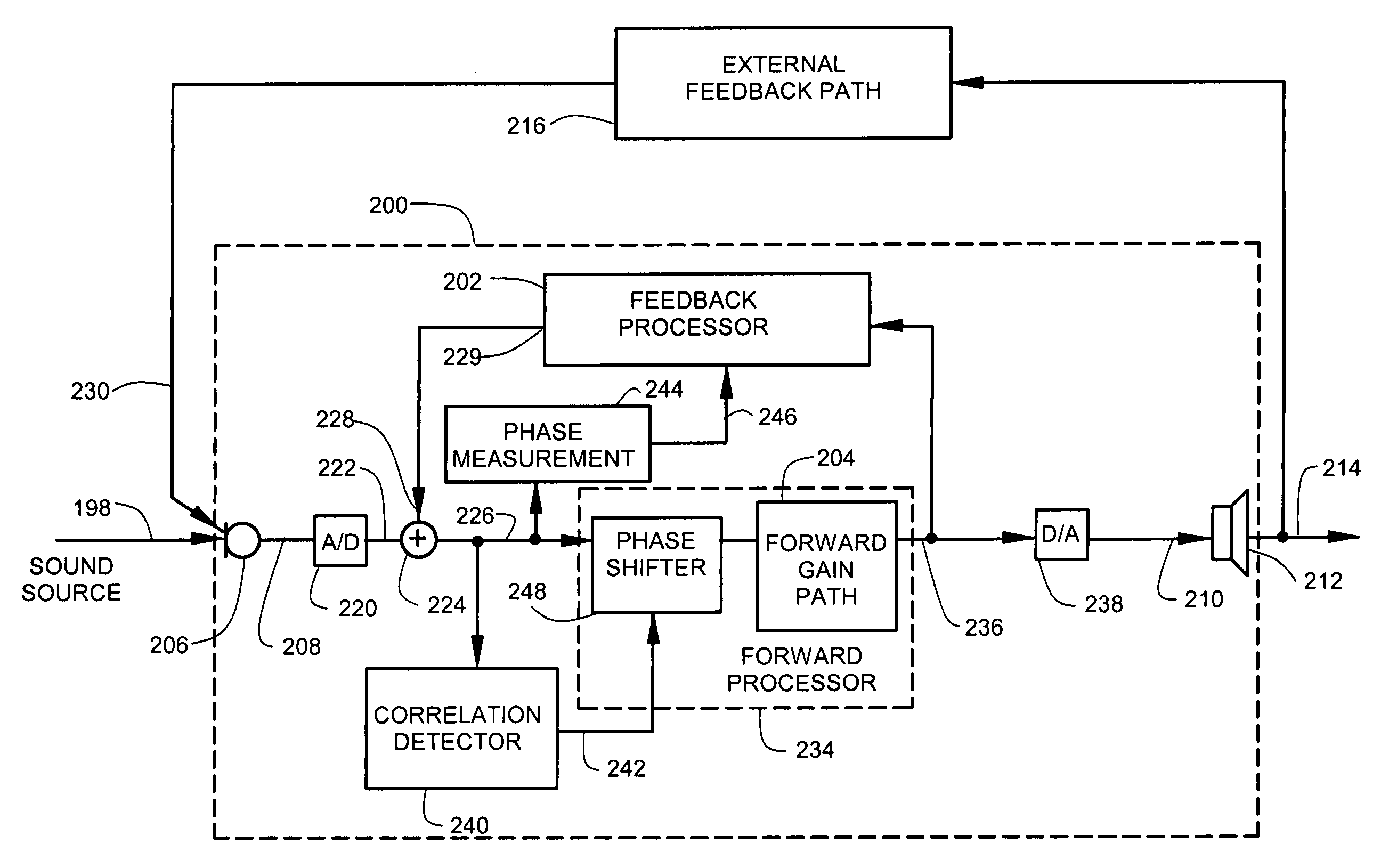Hearing aid circuit reducing feedback
a hearing aid and circuit technology, applied in the field of hearing aid circuits, can solve the problems of unsatisfactory effects, inconvenient fitting of hearing aids, and inability to meet the needs of hearing aids,
- Summary
- Abstract
- Description
- Claims
- Application Information
AI Technical Summary
Benefits of technology
Problems solved by technology
Method used
Image
Examples
first embodiment
[0033]FIG. 2 illustrates a block diagram of a hearing aid circuit 200 that includes an adjustable internal feedback path controlled by a small phase shift measurement (SPM) algorithm. The SPM algorithm is able to differentiate true hearing aid feedback from highly correlated sounds from the environment. The SPM algorithm provide fast internal feedback correction for hearing aid feedback without distorting highly correlated environmental sounds. Such fast internal feedback correction could not be used in the PRIOR ART arrangement in FIG. 1 without distorting the environmental sounds. The arrangement shown in FIG. 2 provides the user with a desired range of amplified environmental sounds without the disadvantages of high hearing aid feedback and distortion.
[0034]The hearing aid circuit 200 provides amplification along a feedforward path 234 in an environment that is subject to external audio feedback path 216. A correlation detector 240 detects correlation at a feedforward path input ...
second embodiment
[0050]FIG. 5 illustrates a block diagram of a second embodiment that includes an SPM algorithm. This embodiment uses very simple circuit elements. The correlation detector 540 and the phase measurement circuit 544 are modification of standard LMS elements. The phase shifter 248 is implemented with a small variable delay.
[0051]The hearing aid circuit 500 provides amplification along a feedforward path 534 in an environment that is subject to an external audio feedback path 516. A correlation detector 540 (which is combined with a phase measurement circuit 544) detects correlation at a feedforward path input 526 and generates a correlation output 542. A variable delay phase shifter 548 receives the correlation output 542. The variable delay phase shifter 548 introduces a phase shift along the forward path 534 as a function of the correlation output 542. In a preferred arrangement, the phase shift has a non-interfering amplitude that is small enough to be imperceptible to the user.
[005...
third embodiment
[0069]FIG. 8 illustrates a block diagram of a hearing aid circuit 400 that includes an adjustable internal feedback path controlled by an SPM algorithm. The hearing aid circuit 400 is preferably realized using a Toccata digital signal processor available from dspfactory, Ltd., 611 Kumpf Drive, Unit 200, Waterloo, Ontario, N2VIK8, Canada. Other digital signal processors can be used as well.
[0070]The hearing aid circuit 400 comprises a summing circuit 424 that receives an audio output 422. The audio output 422 includes audio from a sound source 398 and audio from audio feedback 430 received from a receiver via an external feedback path (not illustrated). The summing circuit 424 also has a second summing input 428 and a net sum output 426.
[0071]A forward processor 434 receives the net sum output 426 and provides a processed output (feedforward output) 436. The forward processor 434 includes a Weighted Overlap-Add (WOLA) analyzer 450 that receives the net sum output 426. The WOLA analyz...
PUM
 Login to View More
Login to View More Abstract
Description
Claims
Application Information
 Login to View More
Login to View More - R&D
- Intellectual Property
- Life Sciences
- Materials
- Tech Scout
- Unparalleled Data Quality
- Higher Quality Content
- 60% Fewer Hallucinations
Browse by: Latest US Patents, China's latest patents, Technical Efficacy Thesaurus, Application Domain, Technology Topic, Popular Technical Reports.
© 2025 PatSnap. All rights reserved.Legal|Privacy policy|Modern Slavery Act Transparency Statement|Sitemap|About US| Contact US: help@patsnap.com



